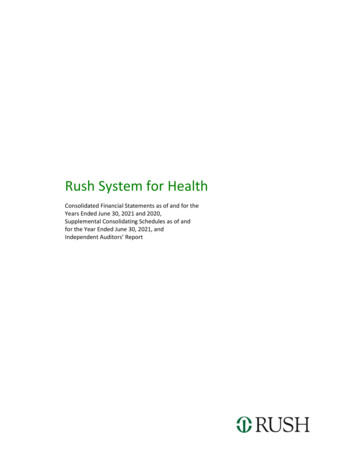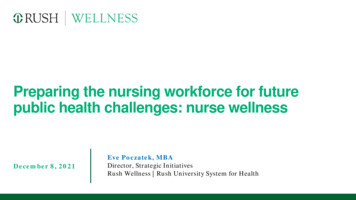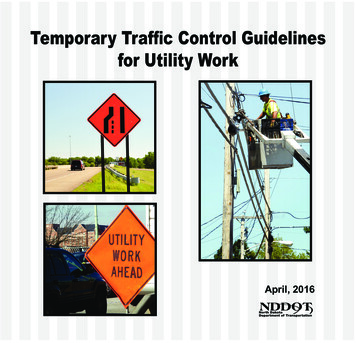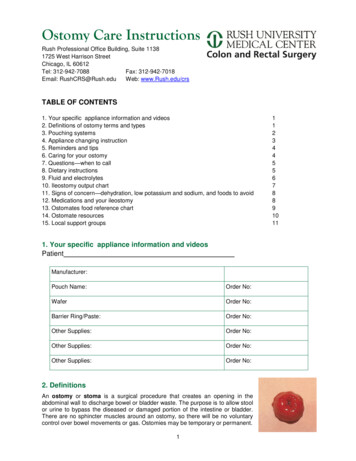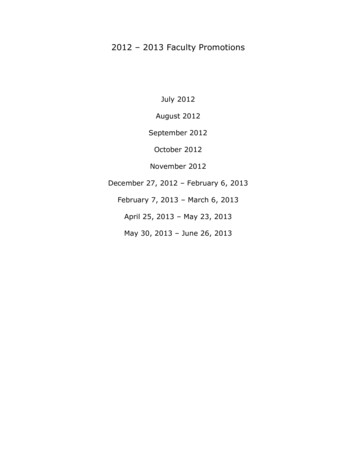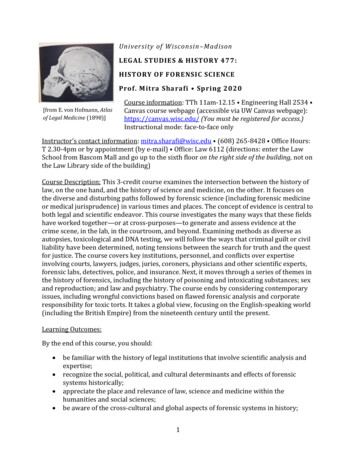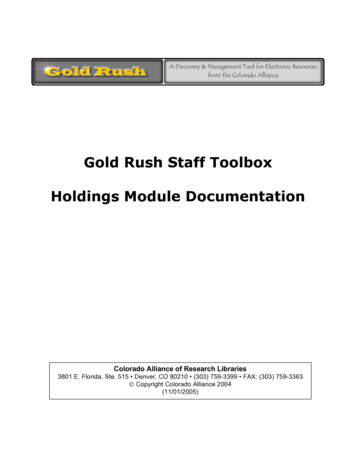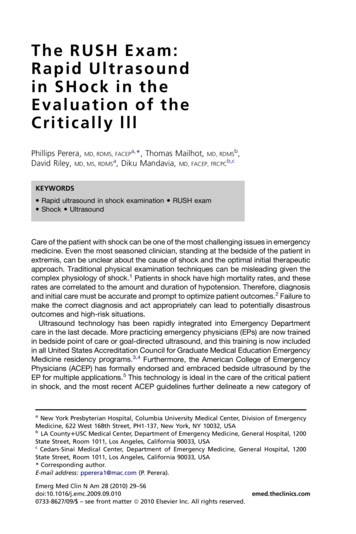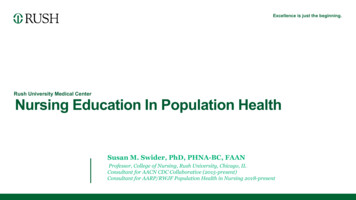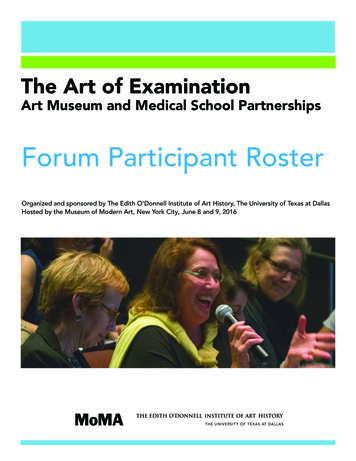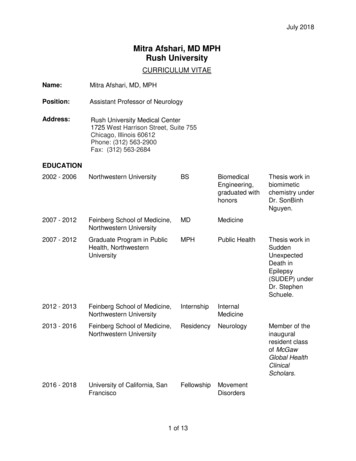
Transcription
July 2018Mitra Afshari, MD MPHRush UniversityCURRICULUM VITAEName:Mitra Afshari, MD, MPHPosition:Assistant Professor of NeurologyAddress:Rush University Medical Center1725 West Harrison Street, Suite 755Chicago, Illinois 60612Phone: (312) 563-2900Fax: (312) 563-2684EDUCATION2002 - 2006Northwestern UniversityBSBiomedicalEngineering,graduated withhonors2007 - 2012Feinberg School of Medicine,Northwestern UniversityMDMedicine2007 - 2012Graduate Program in PublicHealth, NorthwesternUniversityMPHPublic Health2012 - 2013Feinberg School of Medicine,Northwestern UniversityInternshipInternalMedicine2013 - 2016Feinberg School of Medicine,Northwestern UniversityResidencyNeurology2016 - 2018University of California, SanFranciscoFellowshipMovementDisorders1 of 13Thesis work inbiomimeticchemistry underDr. SonBinhNguyen.Thesis work inSuddenUnexpectedDeath inEpilepsy(SUDEP) underDr. StephenSchuele.Member of theinauguralresident classof McGawGlobal HealthClinicalScholars.
July 2018PRIMARY POSITIONS HELD2018-presentRush University, Department of NeurologyParkinson’s Disease and Movement Disorders ProgramAssistant Professor of NeurologyLICENSES, CERTIFICATION2012Medical License, The Medical Board of Illinois2016Medical License, The Medical Board of California2016DEA Certification Number (active)2016Board Certification, American Board of Psychiatry & Neurology2018Medical License (active), The Medical Board of IllinoisHONORS AND AWARDS2006Student Award for Excellence in ResearchResearch Project: A Catechol-Functionalized(Salphen)ZnII Molecular Tweezer: Synthesis andApplication as an Artificial Enzyme for AcylTransfer Reaction.Awarded to one graduating senior in BiomedicalEngineering.Department of BiomedicalEngineering,Northwestern University2006Student Award for Excellence in DesignSenior Project: Shoulder Dystocia SimulationMannequin--The Sally Doll.Department of BiomedicalEngineering,Northwestern University2008Feinberg Office of Minority and Cultural AffairsFeinberg School ofStudent GrantMedicine,Awarded to pursue culturally-sensitive research in Northwestern UniversityUganda.2008Program in Public Health GrantAwarded to pursue Public Health research inUganda.Graduate Program inPublic Health,Northwestern University2008Student "Voices from the Field" SymposiumChosen to present field research work on infantHIV diagnostics in Uganda.Feinberg School ofMedicine,Northwestern University2008“Feinberg Spotlight”Chosen to be featured on the School of Medicinewebsite for research work in Uganda.Feinberg School ofMedicine,Northwestern University2009Public Health Travel FundAwarded to attend the 6th Annual Unite for SightGlobal Health & Innovation Summit at YaleUniversity.Graduate Program inPublic Health,Northwestern University2 of 13
July 20182010Runner-up team, 2010 Social Entrepreneurship inHealth & Wellness Competition, sponsored by theCHEST FoundationKellogg School ofManagement,Northwestern University2011Global Health Initiative Travel GrantAwarded to pursue a clinical service trip in theHimalayan region of India.Center for Global Health,Feinberg School ofMedicine,Northwestern University2011International Health FellowshipCenter for Global Health,Awarded to pursue an infectious disease research Feinberg School ofproject in Uganda.Medicine,Northwestern University20122012 International Emory Global HealthCompetitionChosen to be a member of the first-everNorthwestern team to compete.2015Travel AwardAmerican Academy ofAwarded to one Neurology resident chosen by our Neurologyresidency program to travel to the annual AANconference, during my PGY3 year.2015McGaw Global Health Clinical ScholarsChosen as one of the founding members toparticipate in this training program.Center for Global Health,Feinberg School ofMedicine,Northwestern University2015Acute Stroke Door-to-Needle Time AchievementAwardAwarded for a door-to-needle time of 18 minutes.Department of Neurology,Feinberg School ofMedicine,Northwestern University2017Medtronic Healthcare Professional-in-TrainingMedtronicGrantAwarded to attend the Advanced Deep BrainStimulation for Movement Disorders Conference inGrenoble, France in October 20172018MDS-PAS Fellowship ScholarshipEmory Global HealthInstitute, Emory UniversityInternational Parkinson andMovement DisorderSocietyKEYWORDS/AREAS OF INTERESTooooooParkinson’s DiseaseNeurostimulation and neuromodulation for the treatment of Parkinson’s disease, tremor disorders,dystonia, and other movement disordersDeep brain stimulationBotulinum toxin injections, dystonia, spasticityTelemedicine, telehealth, teleneurology, telerehabilitationPalliative care3 of 13
July 2018ooooClinical outcomes researchMedical education, curriculum developmentQuality-improvementEpidemiology, epigenetics, genetics and environment interactionCLINICAL ACTIVITIES SUMMARYI am a young Neurologist who is specializing in Parkinson’s Disease (PD) and MovementDisorders (such as dystonia and tremor disorders). I completed my two-year MovementDisorders fellowship at the University of California, San Francisco (UCSF), both at the UCSFMovement Disorder and Neuromodulation Center and the San Francisco VA’s Parkinson’sCenter of Excellence (SFVAMC PADRECC). My training at UCSF was under the guidance ofacademic Neurologists, Drs. Caroline Tanner, Jill Ostrem, Philip Starr, Paul Larson, NicholasGalifianakis, Marta San Luciano, Ian Bledsoe, and Alexandra Nelson.At UCSF, I trained at one of the leading and busiest multidisciplinary deep brain stimulation(DBS) centers in the world. I participated in the comprehensive care of patients withMovement Disorders, especially PD and dystonia, and was intimately involved inmultidisciplinary consultations with Neurology, Neurosurgery, and Neuropsychiatry regardingsurgical candidacy, follow-up treatment which includes advanced DBS programming,medication management, and more recently, even the practice of intestinal levodopa infusions(i.e. Duopa). I also participated in the botulinum toxin injection clinic, one of the busiest innorthern California, and learned injection techniques and strategies from four different seniorattendings with the use of electromyography as well as ultrasound in the treatment of dystonia,spasticity, blepharospasm, and hemifacial spasm.At the SFVAMC PADRECC clinic, I was afforded two unique opportunities: training inteleneurology, where I conducted both follow-up and new patient evaluations over video, aswell as training in advanced Movement Disorders care via our monthly palliative care clinic.The SFVAMC PADRECC is one of few centers that has championed telemedicine as part ofstandard clinical care, and they have innovated the use of telemedicine to evaluate potentialDBS candidates across the country. UCSF is also a leading site for recent NIH-funded clinicalprojects aimed at developing palliative care for parkinsonian disorders, and the SFVAMCPADRECC has developed a monthly Supportive Care Clinic in which I trained in as a fellow.In terms of innovation, telemedicine and palliative care for Movement Disorders has becomea focus of my early career now. During my 2 years at UCSF, I helped my Fellowship ProgramDirector, Dr. Nicholas Galifianakis, develop and implement a curriculum for a first-in-its-kindteleneurology rotation for UCSF Neurology senior residents at the SFVAMC. Along with ourcolleagues at Johns Hopkins University, Dr. Galifianakis and I have also partnered andlaunched a multidisciplinary palliative care telemedicine clinic for patients with atypicalparkinsonian disorders, a project that is ongoing and funded by the Movement DisordersSociety (MDS). Dr. Galifianakis and I most recently partnered with the UCSF Physical Therapydepartment and developed a pilot study of “telerehabilitation” or “telephysical therapy” forearly-PD patients to help prevent falls, funded by the Parkinson’s Foundation.I am joining the Neurology faculty at Rush University as a Movement Disorders specialist as ofAugust 2018, where I will be seeing a variety of Movement Disorders referrals and will besignificantly involved in their DBS program. I will be a part of the multidisciplinary DBS at Rushwhere I will be evaluating patients from within our practice and outside for DBS, performingpost-operative DBS programming, and managing their longterm care. I will also be performingbotulinum toxin injections for the treatment of dystonia and other Movement Disorders.4 of 13
July 2018MEMBERSHIPS2005 - 2006Tau Beta Pi Honors Engineering Society2013 - present American Academy of Neurology2016 - present International Parkinson and Movement Disorder Society (MDS), YoungMembers GroupSERVICE TO PROFESSIONAL PUBLICATIONS2018 - present Reviewer, Movement Disorders Clinical Practice2017 - 2018Co-reviewer, 2 publications with Dr.Jill Ostrem of UCSF for JAMA NeurologyINVITED PRESENTATIONS2014Neuroanatomy Case Presentation:Acute MeningoencephalomyelitisDepartment of Neurology, Northwestern UniversityPresenter(resident)2015Diffuse Leptomeningeal Rosai-Dorfman Disease--Case of a22 year old woman who presented with acute right-sided acutehearing loss, pain, and tinnitusGrand Rounds, Department of Neurology, anatomy Case Presentation: HemiballismusDepartment of Neurology, Northwestern UniversityPresenter(resident)2015-2016Morbidity & Mortality Conference for General Neurology Service PresenterDepartment of Neurology, Northwestern University(resident)2015-2016Morbidity & Mortality Conference for Stroke ServiceDepartment of Neurology, Northwestern University2016Basics of NeuroradiologyPresenterMedical Student Neurology Clerkship, Department of Neurology, (resident)Northwestern University2016Motivators and Barriers to Exercise in Parkinson's DiseaseGrand Rounds, Department of Neurology, cranial Dural Arteriovenous Fistulas--Case of a 28 year oldman who presented with acute ataxia, dysarthria, and troublebreathingGrand Rounds, Department of Neurology, cranial MRI-guided Focused Ultrasound Lesioning:A review of the literature for essential tremorBasal Ganglia Journal Club, University of California, SanFranciscoPresenter(fellow)5 of 13Presenter(resident)
July 20182017The Gut & PD: Connections between Microbiota and PDPathogenesisMovement Disorders Interest Group, University of California,San FranciscoPresenter(fellow)2017Zonisamide in Movement Disorders: A review of the literatureUCSF-UCLA Joint PADRECC Journal ClubPresenter(fellow)2017MR Imaging Guidelines in Deep Brain StimulationBay Area Basal Ganglia Club, San Francisco, CaliforniaPresenter(fellow)2018A review of Extended-Release Amantadine ER for LevodopaInduced Dyskinesias in PD—The EASE-LID StudyUCSF-UCLA Joint PADRECC Journal ClubPresenter(fellow)2018New Disease-Modifying Drug Trials for Parkinson’s DiseaseBay Area Basal Ganglia Club, San Francisco, CaliforniaPresenter(fellow)CONTINUING EDUCATION AND PROFESSIONAL DEVELOPMENT ACTIVITIES20148th Annual John Hopkins Dystonia and Spasticity PracticumRush University and John Hopkins University, Chicago, IL2015International Parkinson & Movement Disorders Society School of YoungNeurologistsEmory University, Atlanta, GA2015American Academy of Neurology (AAN) 67th Annual MeetingWashington, DC2015American Academy of Neurology (AAN) 68th Annual MeetingVancouver, BC2015New Frontiers in the Diagnosis and Management of Movement DisordersNorthwestern University, Chicago, IL2016A Comprehensive Review of Movements Disorders for the Clinical PractitionerAspen, CO20165th Annual Cleveland Clinic Comprehensive Neurotoxin Course forNeurological ConditionsCleveland Clinic, Cleveland, OH2016-2018“Bay Area Basal Ganglia Club” (UCSF, Stanford, Parkinson’s Institute, Kaiserand other community Movement Disorders Specialists), San Francisco, CA2016-2018UCSF Movement Disorders Interest Group, San Francisco, CA2017-20181st and 2nd Annual UCSF Movement Disorders Research RetreatSan Francisco, CA201750th Annual UCSF Recent Advances in Neurology ConferenceSan Francisco, CA6 of 13
July 201820172017 International Congress of Parkinson’s Disease & Movement DisordersVancouver, BC2017Advanced Deep Brain Stimulation for Movement Disorders ConferenceInstitut des Neurosciences, Grenoble, France2017Allergan Neuroscience Regional Botulinum Toxin Injection Training CadaverCourseAllergan, Irvine, CA20176th Annual Comprehensive Neurotoxin Course for Neurological ConditionsCleveland Clinic, Cleveland, OH2017Medtronic DBS Graduating Fellows ProgramMinneapolis, MN2018American Academy of Neurology (AAN) 70th Annual MeetingLos Angeles, CA2018Parkinson Study Group (PSG) 29th Annual Meeting and SymposiumJersey City, NJ20182nd Pan-American Parkinson’s Disease and Movement Disorders Congress(MDS-PAS)Miami, FLDEPARTMENTAL SERVICE2008 - 2009Medical school admissions committee member2016 - 2018Teleneurology resident rotation: curriculum design,implementation, and instructionFeinberg School ofMedicine,NorthwesternUniversityUniversity ofCalifornia, SanFranciscoCOMMUNITY AND PUBLIC SERVICE2007 - 2009Chicago Youth Programs Pediatric ClinicFeinberg School of Medicine, Northwestern UniversityLead a weekly free Pediatric clinic for underservedchildren.Coordinator2007 - 2008Chicago Youth Programs Art ProgramFeinberg School of Medicine, Northwestern UniversityLead a weekly afterschool arts program for underservedchildren.Coordinator20081st Annual Alternative Spring BreakFeinberg School of Medicine, Northwestern UniversityPlanned and participated in a weeklong service trip to aNative American community in South Dakota.Founding member7 of 13
July 20182011Rural Medicine in MexicoOaxaca, MexicoWorked in underserved Primary Care clinics in PuertoEscondido, Mexico, developed and delivered PublicHealth talks on infectious disease vector control andmaternal and child health.Founding member2011Himalayan Health ExchangeHimachal Pradesh, IndiaEmbarked on a 30-day expedition through the HimalayanMountains, setting up clinics at 7 sites to providehealthcare for local underserved populations.ParticipantCONTRIBUTIONS TO DIVERSITYI am a 1st-generation immigrant from Iran and one of 3 sisters. My parents immigrated to theUnited States from their home in Iran during the Iranian Revolution in order to unlockeducational opportunities for their daughters, making many sacrifices in their own careers andpersonal lives. From a young age, I was taught the values of hard work and perseverance,and that you must earn your opportunities. My very humble beginnings allow me to be able toconnect with a diverse range of patients and professionals. And a significant portion of mywork thus far reflects how I gravitate towards those who are underserved and underprivileged,as seen in my community service, Public Health, and Global Health work.Of note, while in medical school, I spearheaded a student group called the Health DisparitiesTaskforce. Our group worked to educate students about disparities in health and healthcareaccess. I helped to organize an inaugural 2-week speaker series of leaders in this field fromaround the nation, which has since become a part of the 1st year medical school corecurriculum.TEACHING SUMMARYDuring my undergraduate years, I realized my love for teaching and this is now fueling mydesire to be an academic Neurologist. I was chosen by my professors to act as a Teacher’sAssistant for two undergraduate courses in the Department of Biomedical Engineering and theDepartment of Asian & African Languages: Biothermodynamics and Elementary Farsi,respectively. In medical school, I led a student group of likeminded 2nd year students todevelop “mock” anatomy practical examinations for our class. When I decided on Neurologyas my specialty, I wrote an educational piece for the Residents & Fellows ‘Pearls & Oy-sters’section of Neurology with my faculty mentor during my 4th year of medical school. Duringresidency, I was involved in many educational activities as well: I spearheaded the creation ofour residency’s clinical pocket ‘Neurology Survival Guide,’ worked as a Neurology ProblemBased Learning instructor for 1st and 2nd year medical students for 2 years, and lead multiplelumbar-puncture training workshops for medical students.During my fellowship at UCSF, in addition to being involved in the development andimplementation of UCSF’s resident Teleneurology curriculum with my fellowship programdirector, Dr. Nicholas Galifianakis, I have been a leader with regards to improving theeducational experience. For the Teleneurology rotation, I developed a survey-basedobservational study of residents who rotated through this curriculum to evaluate efficacy,barriers, and knowledge-base of telemedicine, ultimately with the goal to improve the rotation(being submitted for publication to the Residents & Fellows section of Neurology). For the8 of 13
July 2018fellowship, I worked alongside Dr. Galifianakis to develop and launch 2 new fellows’ teachingconferences: “Hot Topics in Movement Disorders” and the “Gaps Conference.” I also workedalongside Dr. Nijee Luthra, the newest junior Movement Disorders faculty at UCSF, to draftand edit a “Fellows’ Handbook” for our incoming fellows. This is a 30-page guide that includesdetails on several logistical considerations for the fellowship and clinic (schedules, phonenumbers, billing, coding, genetic testing, specialty medication orders, etc.) as well as guides onproviding Movement Disorders patients at the SFVAMC and UCSF with the best resources(advanced care, support groups, etc.).FORMAL nSchoolClassSize2005 - 2006 Biothermodynamics Teacher's AssistantDepartment of BiomedicalEngineering, NorthwesternUniversity2005 - 2006 Elementary FarsiTeacher's AssistantDepartment of Asian & African 3Languages, NorthwesternundergraduatesUniversity2014 - 2015 Problem-BasedLearning Course,Neurology sectionInstructorFeinberg School of Medicine,Northwestern University81st and 2ndyear medicalstudents2015 - 2016 Lumbar PunctureTrainingInstructorFeinberg School of Medicine,Northwestern University63rd and 4thyear medicalstudents2016-2018InstructorDepartment of Neurology,Division of MovementDisorders, University ofCalifornia, San Francisco113rd and 4th sRESEARCH SUMMARYDuring my undergraduate years, I completed a rigorous curriculum in Biomedical Engineeringwhere I graduated with Departmental Honors and was recognized at my graduation for myresearch work in biomimetic synthetic chemistry. During medical school, I completed acombined MD-MPH during my 4 years, ultimately completing my MPH research thesis work onSudden Unexplained Death in Epilepsy (SUDEP). However, during my years in medicalschool, I also traveled to Mexico, India, and Uganda in my dedication to Global Health for bothclinical and research-related trips. One of these projects involved contributing to the initial fieldresearch required to launch a novel point-of-care, rapid infant HIV diagnostic device inUganda, bridging my Biomedical Engineering, Medical, and Public Health backgrounds. Thiswork was funded by the Grand Challenges in Global Health Grants of the Bill & Melinda GatesFoundation and was presented at multiple conferences relevant to HIV. The device has nowbeen developed and piloted abroad by Biomedical Engineering Professor Dr. David Kelso atNorthwestern University.9 of 13
July 2018During residency, I contributed to multiple publications/poster presentations across Neurologysubspecialties. I graduated my residency having submitted 5 of the 7 publications/posterpresentations produced from members of my graduating class over the course of ourresidency.Below is a summary of my latest research work in the field of Movement Disorders. My currentresearch interests in Movement Disorders include the epidemiology of PD, clinical trials,telemedicine, Neurology education and curriculum development, palliative care in MovementDisorders, and quality-improvement strategies.Exercise in Parkinson’s DiseasePrincipal Investigator2016During my final year of residency, I pursued an cross-sectional survey-based study into themotivators and barriers that impact exercise participation in PD. I was able to collect 215surveys from PD patients over 4 months and draw important conclusions that were thenpresented at the 20th International Congress of Parkinson’s Disease and Movement Disordersin Berlin in June 2016. This work was published in the Journal of Parkinson’s Disease inNovember 2017.Parkinson’s Disease Inpatient OrdersetPrincipal Investigator2015-ongoingI contributed to a hospital quality-improvement project where we have created and nowlaunched the first-ever PD-specific inpatient orderset at Northwestern Memorial Hospital.A previous retrospective chart review of PD inpatients had found that in one year, 50.5% of thispatient population experienced medication errors or did not get their medications at all. Thisorderset tries to combat this issue and includes: medication reconciliation, PD-specificmedications with various dosing options, a list of contraindicated medications for PD patients,built-in nursing alerts for medication administration, safety-related orders, and PD-specificphysical and occupational therapy orders. The preliminary results of this project werepresented at the 29th Parkinson Study Group Meeting in May 2017, and final results will bepresented at the 2018 International Congress of Parkinson's Disease and Movement Disordersin Hong Kong, China.Clinical Trial of Immunotherapy in Parkinson’s DiseaseSite Study ClinicianSponsor: F. Hoffman-La Roche, Ltd.2017-ongoing“A Randomized, double-blind, placebo-controlled, 52-week phase II study to evaluate theefficacy of intravenous RO7046015 (PRX002) in participants with early Parkinson’s Diseasewith a 52-week blinded extension.” (PASADENA), PROTOCOL BP39529While at UCSF, I was a study site clinician on the one of the first Phase II trials of a monoclonalantibody directed against an epitope in the C-terminus of human α-synuclein in early-stageParkinson’s Disease under the principal investigators Drs. Caroline Tanner and Jill Ostrem andsponsored by Roche. I was able to attend the Investigator’s Meeting for this study and washeavily involved in the IRB application process and logistical planning of the studyimplementation as this was actually one of our division’s first clinical drug trials. As a studyclinician, I assisted in the recruitment, screening, enrollment, and evaluations of the first10 of 13
July 2018several subjects, including performing common PD-specific rating scales, skin biopsies, andlumbar punctures.Imaging-Guided DBS Programming Support ToolSite Study ClinicianSponsor: NIH-NINR (R01 grant)2017-ongoingI was leading UCSF’s efforts as part of a multicenter trial that is testing the efficacy of animaging-guided DBS programming support tool developed by Professor Christopher Butsonfrom the University of Utah, who had partnered alongside our Movement Disorders colleague atthe University of Florida, Gainesville, Dr. Michael Okun. This trial is funded by an R01 grantfrom the National Institute of Health-National Institute of Nursing Research (NIH-NINR). ThisiPAD-based support tool brings patients’ own post-DBS imaging via computational modeling tothe bedside to predict the volume-of-tissue-activated with different DBS stimulation parameters,making the DBS programming process easier and more time-efficient.Teleneurology Curriculum for Neurology ResidentsCo-Principal Investigator2017-ongoingAlongside Dr. Nicholas Galifianakis, a champion in the work of telemedicine in Neurology, Ihave been involved in the development and implementation of a “Teleneurology” curriculum forsenior Neurology residents, one of the first-in-its-kind. We have also developed and launcheda survey-based observational study of residents to evaluate efficacy, barriers, and knowledgebase on telemedicine before and after this rotation. And we presented our results of this studyat the 70th Annual American Academy of Neurology Meeting in Los Angeles in April 2018 andthe 2nd Pan-American Parkinson’s Disease and Movement Disorders Congress. In Miami inJune 2018. I have been approached by several residency program directors for guidance asthey develop their own rotations, and we are drafting a manuscript of our work for theResidents & Fellows section of Neurology.Palliative “Virtual Home Visits” in Atypical Parkinsonian sor: International Parkinson and Movement Disorder Society (MDS)With UCSF being a leading site for recent NIH-funded clinical research aimed at developingmultidisciplinary palliative care clinics for patients with advanced parkinsonism, I teamed upwith Dr. Nicholas Galifianakis again and our colleague Alexander Pantelyat at Johns HopkinsUniversity to launch an observational pilot study at UCSF aimed at delivering this type of careusing telemedicine technology to atypical parkinsonian patients. We hope to demonstrate that“virtual” visits directly into the patient’s home with a team consisting of a Movement Disordersspecialist, nurse, chaplain, and social worker who focus on palliative care principles, canovercome the many barriers to accessing this type of care and improve other QOL measuresfor this patient population and their caregivers. This project is funded by the MDS; in fact, itwas the single telemedicine clinical project to be funded by the MDS in 2017.A Novel Telerehabilitation Strategy to Prevent Falls in in Parkinson’s DiseaseSub-Investigator2017-ongoingSponsor: Parkinson’s FoundationDrs. Tanner, Galifianakis, and I, along with our UCSF physical therapy colleagues, havedeveloped an observational pilot study of “telerehabilitation” or “telephysical therapy” to prevent11 of 13
July 2018falls in PD, which was funded by a Parkinson’s Foundation Community Grant in Winter 2017and is currently enrolling UCSF patients. Telerehabilitation is a novel concept in thetelemedicine and physical therapy worlds that is growing in popularity. The goal of this study isto evaluate the feasibility, safety, and efficacy of delivering physical therapy remotely to PDpatients using teleconferencing technology.PEER-REVIEWED PUBLICATIONS1. Cho, S-H, Gadzikwa T, Afshari M, Nguyen ST, Hupp JT. [Bis(catechol)salen]MnIIICoordination Polymers as Support-Free Heterogeneous Asymmetric Catalysts forEpoxidation. European Journal of Inorganic Chemistry. 2007; 31: 4863-4867.2. Afshari M. Author, Step 1 Qmax, 2010 edition. Published by MedIQ Learning, LLC.Available at: http://www.usmlerx.com.3. Schuele SU, Afshari M, Afshari ZS, Macken MP, Asconape J, Wolfe L, Gerard EE. Ictalcentral apnea as a predictor for sudden unexpected death in epilepsy. Epilepsy &Behavior. 2011; 22: 401-403.4. Afshari M, Afshari ZS, Schuele SU. Pearls & Oy-sters: Hashimoto Encephalopathy.Neurology. 2012 May 29;78(22):e134-7.5. Afshari M. A Case of a 24 year-old man with acute onset of bilateral vision loss. Annals ofClinical and Translational Neurology. interactn.org.6. Afshari M, Yang A, Bega D. Motivators and barriers to exercise in Parkinson's Disease.Journal of Parkinson's Disease. 2017;7(4):703-711.7. Afshari M, Galifianakis NG. Education Research: A Telemedicine Curriculum forNeurology Residents. Neurology. Resident & Fellow Section. In preparation.BOOK CHAPTERS1. Afshari M, Ostrem J, Starr P. Bilateral ventralis intermedius (Vim) thalamic deep brainstimulation (DBS) for medication-refractory orthostatic tremor. Deep Brain Stimulation: ACase-Based Approach. In: Chitnis S, Khemani P, Okun M, eds. Oxford University Press.In Submission.2. Afshari M, Ostrem J, San Luciano M, Larson P. Rescue ventralis intermedius (Vim)thalamic deep brain stimulation (DBS) to address refractory tremor following subthalamicnucleus (STN) DBS with associated stimulation-induced dyskinesia. Deep BrainStimulation: A Case-Based Approach. In: Chitnis S, Khemani P, Okun M, eds. OxfordUniversity Press. In Submission.CONFERENCE ABSTRACTS1. Latigo M, Afshari M, Palamountain K, Kelso D. Exploring the feasibility of introducingrapid infant HIV testing in Ugandan prevention-of-mother-to-child-transmission (PMTC)clinics. 5th IAS Conference on HIV Pathogenesis, Treatment and Prevention. Cape Town,South Africa, 2009.12 of 13
July 20182. Latigo M, Afshari M, Palamountain K, Kelso D. Can single sample infant HIV test deviceshandle current test volumes in Ugandan health facilities? 1st International Workshop onHIV Pediatrics. Cape Town, South Africa, 2009.3. Afshari M, Latigo M, Palamountain K, Kelso D. Assessing the need for rapid point-of-careinfant HIV testing in Ugandan PMTC clinics. 137th Annual American Public HealthAssociation Meeting and Exposition Student Poster Session. Philadelphia, PA, 2009.4. Afshari M, Schuele S. Ictal central apnea as a predictor for SUDEP. American EpilepsySociety Annual Meeting. San Antonio, TX, 2010.5. Afshari M, Raizer J. Diffuse Leptomeningeal Rosai-Dorfman Disease: A Case Report.American Academy of Neurology 67th Annual Meeting. Washington, D.C., 2015.6. Nadkarni N, Afshari M, Kim M. "Spot Sign" After Trauma Suggestive of Venous SinusRupture: A Case Report. American Academy of Neurology 68th Annual Meeting.Vancouver, Canada, 2016.7. Culler G, Afshari M, Maas M. Dural Arteriovenous Fistula, medullary edema, andOndine’s Curse: A Case Report. American Academy of Neurology 68th Annual Meeting.Vancouver, Canada, 2016.8. Afshari M, Kianirad Y, Bega M. MOVE-PD Study: Motivators and Other Variables forExercising in Parkinson's Disease. 2016 International Congress of Parkinson's Diseaseand Movement Disorders. Berlin, Germany, 2016.9. Larson D, Afshari M, Kianirad Y, Ellinger LK, Zadikoff Z. Development of a Parkinson'sDisease-specific Admission Orderset. 29th Annual Parkinson Study Group AnnualMeeting & Symposium on Etiology, Pathogenesis, and Treatment of Parkinson’s Diseaseand
American Academy of Neurology (AAN) 70th Annual Meeting 2018 Parkinson Study Group (PSG) 29th Annual Meeting and Symposium Jersey City, NJ 2018 2nd Pan-American Parkinson's Disease and Movement Disorders Congress (MDS-PAS) Miami, FL DEPARTMENTAL SERVICE 2008 - 2009 2016 - 2018 Medical school admissions committee member
